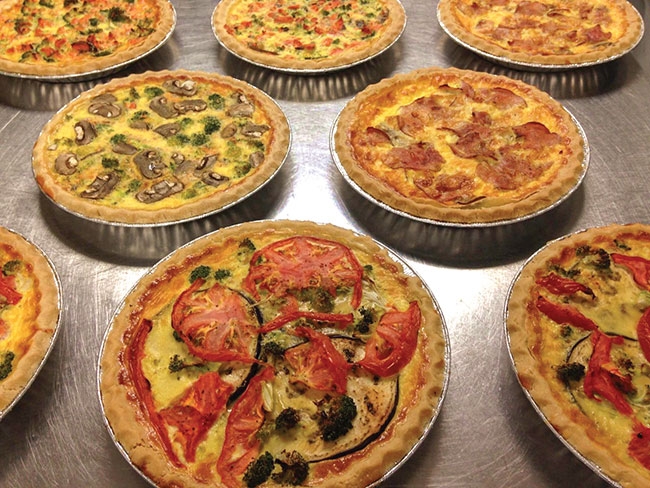
A new look at quiche
May 24, 2019
By Karen Barr
Quiche is back, with a modern twist
 Bakeries, especially smaller ones, seem to be less aware of the health implications of trans fats.
Bakeries, especially smaller ones, seem to be less aware of the health implications of trans fats. How do bakers and pastry chefs keep tradition alive, while accommodating health and wellness, intolerances and a wide variety of preferences?
I decide to call Patisserie Duc de Lorraine in Montreal, Quebec, arguably the quiche eating capital of Canada. At the helm is pastry chef Bruno Cloutier, Montreal-born and Paris-trained.
Most would agree that a crust made from shortening just doesn’t have the same flavour as an all-butter crust. Yet, many feel an all butter crust is too hard to work with and add 50 per cent shortening.
To make his quiche dough Cloutier starts with good quality, cold butter and a mix of all-purpose flour and pastry flour. As a general rule the lower the protein, the more tender the crust. So, mixing high protein Canadian all-purpose flour with pastry flour makes it easier to handle, while keeping it tender.
Once combined, ice water and salt are added and mixed into a firm dough. It is then refrigerated, for two hours to relax the gluten. Dough that hasn’t been chilled long enough will shrink back in the pan.
The dough is rolled on a laminator, until it is two millimeters thick. Then it is cut and placed in a one-piece tart mould measuring 10 inches round and two inches high. Cloutier insists this is the perfect pan for the job. “You want your quiche to be thick. At least that’s how I like them,” the jovial Cloutier tells me.
As a stylized choice Cloutier leaves part of the dough straight edged following the rim of the pan. with small areas of the dough randomly fluted.
For the filling Cloutier combines six to nine eggs depending on the type of quiche being made to one litre of liquid. He alters tradition by replacing 30 per cent of the 35 per cent of cream with homogenized milk. Cloutier then adds salt and pepper and freshly grated nutmeg. Finally, it is baked in a gas oven at 365 F for 1 hour.
Once in the oven the butter in the crust gives off steam, which in turn separates the layers resulting in the perfect flakey texture. Their most popular quiche is its name sake, Quiche Lorraine, made with ham and onion cooked in butter. These fillings are removed from the pan and mixed into grated Swiss cheese.“It is important to mix it well before adding it to the quiche. You want to taste everything in every bite.”
Other quiches include market fresh Vegetable Quiche, Spinach Quiche and Salmon Quiche. For the latter, Cloutier cooks fresh salmon in butter, but also adds smoked salmon to heighten the flavour.
Over at the Silly Yak Bakery in Kingston, Ontario, baker Sarah Rose and her business partner Keven Pearson ensure customers can enjoy wheat-free quiche. “It’s a big gluten-free town,” Rose tells me.
Rose uses her own blend of flour. Rice flour is the predominant grain, with the addition of tapioca flour and cornstarch. Eggs are added to the flour mix. Then, non-dairy margarine, which is added both in solid form and liquid, combined with a bit of water. After relaxing the dough and refrigeration, it is hand-rolled out into a traditional pie plate. “Customers tell us the crust is nice and flakey. Guests don’t even notice it is gluten-free,” says Rose.
As for non-dairy margarine Rose adds, “Often people who have celiac disease are lactose-intolerant as well. Coconut milk is used in place of dairy. For every litre 15 eggs are used. “Coconut milk is much thinner, so many eggs are needed to thicken it,” she explains.
A classic quiche or its contemporary cousin allow for endless options. Explore. Evaluate. But, most of all, enjoy! / BJ
Karen Barr writes about arts, culture and cuisine. She is a graduate of George Brown College and is a Red Seal pastry chef.
Print this page
Leave a Reply